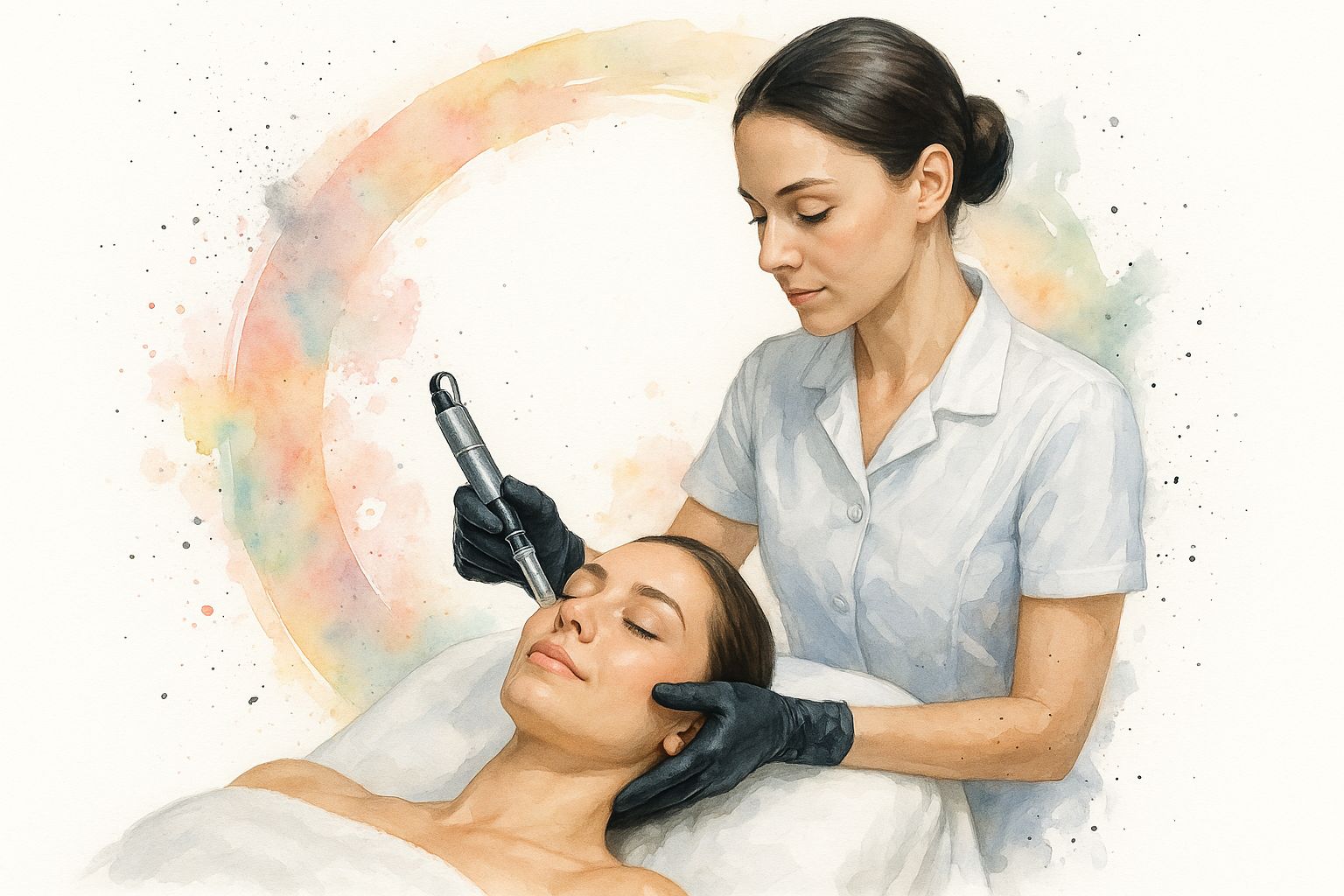
How Often to Microneedle Face for Best Results
When it comes to microneedling, the sweet spot for most people is scheduling a session every 4 to 6 weeks. This isn't just a random number; it's timed perfectly to work with your skin's natural renewal cycle, giving it enough time to heal and build new collagen without overdoing it.
Finding Your Ideal Microneedling Schedule
Figuring out the right microneedling frequency is less about following a strict rule and more about listening to your skin's biological rhythm. Think of it as a partnership with your body's own healing powers.

That 4 to 6 week window gives your skin the critical downtime it needs to fully regenerate. After a treatment, your skin gets busy repairing the micro-channels by laying down a fresh matrix of collagen and elastin.
This healing cascade is where the real magic happens. If you jump into your next session too soon, you risk interrupting that process, which can lead to inflammation and less-than-stellar results. You'd actually be working against your own skin goals.
Why Patience Pays Off
The standard recommendation you'll hear from most dermatologists is an initial series of four to six sessions, each spaced 4 to 6 weeks apart. This isn't just a suggestion—it's a strategy designed to maximize the stimulation of new, healthy tissue with each appointment.
For a deeper dive into how the treatment works from start to finish, this comprehensive guide to microneedling is a fantastic resource.
This strategic waiting period is crucial. It ensures each session builds on the progress of the last, creating a compounding effect that leads to real, lasting improvements in your skin's texture and firmness.
Here’s a quick-reference table to help visualize the standard microneedling schedule and the science behind it.
Standard Microneedling Frequency Guide
| Recommended Frequency | The Science Behind It | Ideal For |
|---|---|---|
| Every 4-6 Weeks | Aligns with the skin's full cell turnover and collagen synthesis cycle, which typically takes about 28-40 days. | General rejuvenation, fine lines, uneven texture, and mild scarring. |
| Every 6-8 Weeks | Allows for more profound healing and collagen remodeling, which can take longer for deeper skin concerns. | Deeper wrinkles, significant sun damage, and more pronounced acne scars. |
| Every 3-6 Months | Once the initial series is complete, this schedule helps maintain the results and supports long-term skin health. | Maintenance phase after achieving initial goals. |
Ultimately, this structured approach ensures you’re giving your skin exactly what it needs to rebuild itself stronger and healthier than before.
Customizing Your Schedule for Your Skin Goals
That 4-to-6-week rule you always hear about? It’s a great starting point, but it's not the whole story. Real, lasting results come from a plan built around your unique skin goals, not a generic template.
Think about it this way: the strategy for tackling deep, stubborn acne scars is going to look very different from a plan to simply maintain a healthy, vibrant glow. Your skin's history and what you want to achieve are what truly dictate the right frequency.
Tailoring Frequency to Your Concerns
Let’s get specific. If you’re dealing with significant texture problems like atrophic acne scars, your practitioner will likely recommend a more intensive initial approach. This often means using a deeper needle depth—somewhere in the 1.5mm to 2.0mm range—every 4 to 5 weeks for the first few treatments. The goal is to be more aggressive in kickstarting collagen production where the tissue is most damaged. We dive deep into this strategy in our guide on microneedling for acne scars.
On the other hand, if you're looking to soften fine lines, shrink the appearance of pores, and just boost your skin's overall radiance, a lighter touch is usually better. For general anti-aging and maintenance, a shorter needle (0.5mm to 1.0mm) every 6 weeks works wonders without overwhelming the skin.
This chart breaks down the recommended intervals based on how sensitive your skin is.

As you can see, anyone with more sensitive or reactive skin really benefits from giving it extra time to heal. If your skin is fairly resilient, that standard four-week turnaround is usually just fine.
To make this even clearer, I've put together a table that outlines some common starting points for different goals. This is a great reference to discuss with your skincare professional.
Personalized Microneedling Plans by Skin Concern
| Primary Skin Goal | Optimal Frequency | Common Needle Depth | Typical Session Count |
|---|---|---|---|
| Deep Acne Scars | Every 4-5 weeks | 1.5mm - 2.0mm | 4-6 sessions |
| Fine Lines & Wrinkles | Every 4-6 weeks | 0.5mm - 1.5mm | 3-5 sessions |
| Hyperpigmentation | Every 4 weeks | 0.25mm - 1.0mm | 3-6 sessions |
| General Radiance/Glow | Every 6-8 weeks | 0.25mm - 0.5mm | 2-3 sessions annually |
Remember, these are just guidelines. Your provider will fine-tune the plan based on how your skin responds after each session, ensuring you get the best possible results safely.
Professional vs At-Home Devices
It's also really important to know the difference between a professional microneedling session and using an at-home dermaroller. Professional treatments go much deeper, creating controlled micro-injuries in the dermis to trigger that powerful collagen-building response. This level of treatment absolutely demands a recovery window of at least four weeks.
At-home rollers, with their tiny 0.25mm to 0.3mm needles, are a completely different tool. They're designed to help your serums absorb better, not to induce collagen. If you use them too often, you risk irritation and damaging your skin barrier, so don't overdo it.
Complementing your treatments with a solid overall skincare philosophy can make a huge difference. Looking into holistic tips for radiant skin is a great way to support your skin from the inside out. In the end, nothing beats a personalized schedule developed with a pro who can assess your skin’s needs and adjust the plan as you go.
The Science Behind Your Skin’s Healing Process
I know it’s tempting to schedule your next microneedling session as soon as possible, thinking it will fast-track your results. But the real magic happens in the downtime between treatments. Let's dig into the science a bit, because understanding what's going on beneath the surface helps make sense of why patience is your best friend here.
After a session, your skin kicks off a fascinating and complex three-phase healing journey.

This entire response is what we call collagen induction therapy. We're essentially creating tiny, controlled injuries to signal the body's powerful, natural repair systems to get to work.
The Three Phases of Skin Repair
Your skin's reaction to microneedling isn't random. It’s a highly organized, predictable process that you don't want to interrupt. Jumping into another session too soon disrupts this delicate sequence, which can backfire and lead to chronic inflammation or just plain disappointing results. Think of it like picking a scab before the new skin underneath has had a chance to fully form.
Here's a play-by-play of what’s happening under the hood:
- Inflammation: This is the immediate first-responder phase. Your immune system rushes to the treated areas to clean things up and set the stage for rebuilding. This initial reaction typically lasts for the first 24 to 72 hours.
- Proliferation: Kicking in around day three, this is when your skin gets busy building new tissue. Specialized cells called fibroblasts start churning out fresh collagen and elastin, creating a brand-new support structure. This is the active regeneration stage, and it can go on for several weeks.
- Remodeling: The final phase can last for months. The new, somewhat delicate type III collagen is gradually replaced by the stronger, more organized type I collagen. This is what ultimately delivers that smoother, firmer, and more resilient skin you're after.
Understanding these stages makes it crystal clear why that 4-to-6-week waiting period is non-negotiable. It gives your skin the full time it needs to complete the proliferation and remodeling cycles, ensuring each treatment builds on a solid foundation of healthy, new tissue.
Scientific research backs this timeline up. Studies have shown that a monthly interval gives the skin the space to properly move through these phases. One key piece of research confirmed that treating wrinkles once every 30 days for four months led to statistically significant improvements. This really drives home that this frequency strikes the perfect balance between stimulating new collagen and allowing for complete recovery. By respecting your skin's natural biological clock, you're setting yourself up for the best possible outcome.
Your Essential Prep and Aftercare Routine
Getting the most out of your microneedling treatment isn't just about what happens in the clinic. The real magic, and your best results, come from how you handle your skin before and after the session. Think of it as a partnership between you and your skin—proper prep and dedicated aftercare are non-negotiable for a quick recovery and that gorgeous, glowing outcome.
What you do in the week leading up to your appointment sets the stage for success. The goal is to get your skin as calm and healthy as possible, which means temporarily hitting pause on some of your go-to products to avoid any extra irritation.
Pre-Treatment Preparation
Before you even walk in for your treatment, you need to create a clean, non-irritated canvas. This means stripping your routine back to the basics for at least five to seven days beforehand.
- No More Exfoliants: Step away from all of them. This means no chemical exfoliants like retinoids (Retin-A, tretinoin), AHAs (glycolic, lactic acid), or BHAs (salicylic acid). It also means putting aside any physical face scrubs.
- Pause Potent Actives: If it's a strong, active ingredient that could make your skin more sensitive, stop using it.
- Hands-Off Hair Removal: Avoid waxing, tweezing, or using any depilatory creams on the area you're having treated for at least a week.
- Stay Out of the Sun: This is a big one. Avoid direct, prolonged sun exposure and absolutely no tanning beds. Showing up with a sunburn means we'll have to reschedule, no exceptions.
Basically, you're putting your skin on a gentle diet. A simple cleanser, a basic moisturizer, and—most importantly—a high-quality daily sunscreen are all you need.
Post-Treatment Aftercare
Once your session is done, your skin enters a delicate, highly absorbent healing phase. The tiny micro-channels are open, making your skin a sponge for hydration but also leaving it incredibly vulnerable. Your focus needs to pivot completely to calming, hydrating, and protecting.
The first 24 to 48 hours are the most important. It's totally normal for your skin to feel tight and look red, almost like you got a bit too much sun. During this window, gentle is the only way to go. I always tell my clients to use a mild, creamy cleanser and layer on products packed with hyaluronic acid and ceramides. These are the heroes of hydration and barrier repair, giving your skin exactly what it craves to heal and rebuild.
For the entire first week post-treatment, you must strictly avoid all active ingredients. That means no vitamin C, no retinoids, and zero exfoliation. Bringing them back into your routine too soon is a recipe for serious irritation and can completely derail your skin's healing process.
Your skin's protective barrier needs time to close up and get strong again. Having a solid recovery plan makes all the difference. For a super detailed timeline and product recommendations, our guide gives you microneedling aftercare instructions that actually work. Following a proven plan like this helps the collagen-building process run smoothly, preventing setbacks and leading you straight to the healthy, revitalized skin you're after.
Recognizing the Signs of Overtreatment
When it comes to microneedling, more is definitely not better. It’s easy to get excited about the results and want to speed things up, but scheduling sessions too close together can seriously backfire. Pushing your skin too hard does more harm than good, so learning to spot the red flags is crucial.
Your enthusiasm is understandable, but your skin will tell you when it’s had enough. These symptoms go beyond typical post-treatment irritation; they’re clear signs that your skin’s protective barrier is in trouble.

This kind of damage is a direct result of not giving your skin enough downtime between sessions. You're essentially interrupting the natural healing cycle before it can finish its work.
Key Warning Signs to Watch For
If you’re trying to figure out how often to microneedle your face without causing problems, keep a close eye out for these tell-tale signs of overtreatment. They signal chronic inflammation and a compromised moisture barrier.
- Persistent Redness and Irritation: Is your skin still looking flushed or feeling tender days after a session? That’s a major warning sign.
- Unusual Breakouts: You might notice new acne, little bumps, or a rough texture that wasn’t there before.
- Heightened Sensitivity: Suddenly, your go-to moisturizer or gentle cleanser starts to sting or burn when you apply it.
- A Waxy or Tight Appearance: Your skin might take on an unnaturally shiny, tight, or almost "plastic-like" look.
When you repeatedly trigger an inflammatory response without allowing for full recovery, you risk long-term issues like hyperpigmentation and even scarring—the very things you're trying to correct.
If you notice any of these signs, it's time to hit the brakes. Stop all treatments immediately and give your skin a much-needed break. Switch your focus to gentle, barrier-supporting products until your skin gets back to a calm, healthy state.
Got Questions About Your Microneedling Schedule?
Once you get the basics down, it's totally normal for more specific questions about your own skin and routine to come up. Feeling confident in what you're doing is everything, so let's tackle some of the most common questions I hear from clients all the time.
A big one is whether it's okay to microneedle at home every two weeks. The short answer is a hard no. This is where the difference between a light at-home roll and a professional treatment really matters. Using those shorter needles too often can lead to constant, low-grade irritation without ever actually stimulating that deep, meaningful collagen you're after. You end up just stressing out your skin's protective barrier for no real gain.
People also ask how to adjust their schedule when they're dealing with something more serious, like deep acne scars.
Dealing With Scars and Managing Expectations
When it comes to deep acne scars, you have to play the long game. Treating them properly means using longer needles to break up that tough, damaged tissue deep within the skin. Because the treatment is more intensive, your skin needs more time to heal and rebuild. Rushing it won't get you there faster—it just gets in the way of the very process you're trying to encourage.
And of course, everyone wants to know: how many sessions until I actually see a difference? You’ll likely notice a temporary "glow" right after a treatment, which is mostly just a bit of swelling and inflammation. But the real, structural changes take time to appear.
You can expect to see a real reduction in scars and wrinkles after a series of 3 to 4 treatments. It takes several months for that new collagen and elastin to fully form and mature.
Think of it like building a new foundation for your skin, one brick at a time. Each session builds on the last, and the real magic happens when you stick with it and give your skin the time it needs.
Ready to create a microneedling plan that's actually designed for your skin and your goals? At Olive Skin Therapy, we specialize in customized treatments that get real, lasting results. Book your consultation today and let's get you started on the path to healthier, glowing skin.
